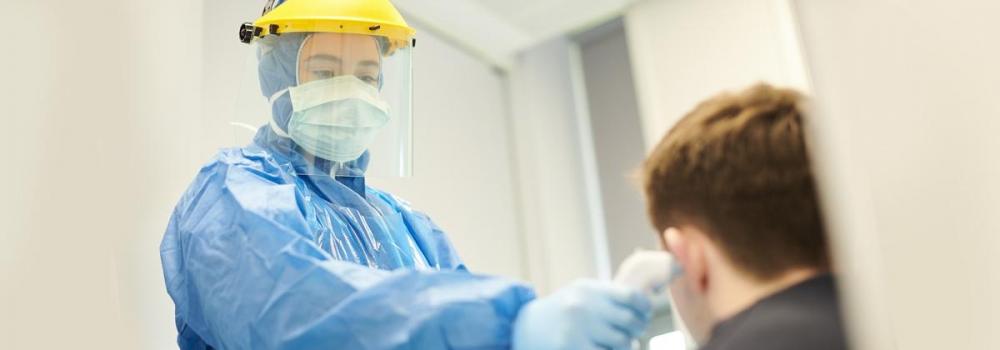Based on experiences in China and Italy, establishing pop-up or field hospitals to treat asymptomatic and or mildly symptomatic COVID-19 patients has proved to be an effective strategy to stop the spread of the highly infectious disease across hospitals and among healthcare workers. The United States has followed suit to help mitigate the effects of the outbreak, setting up fast-response facilities designed to allow existing hospitals to treat patients that require more extensive medical attention. Twenty states have set up field medical facilities or other alternative care sites, including New York City and Boston, where three field hospitals opened in April to treat patients who were being treated for COVID-19 but were not in need of critical care.
While these facilities may be temporary, it's still critical that they monitor temperature, room pressure, humidity control and more to reduce risks to patients and healthcare workers. Hospitals must implement their existing infection control policy in these temporary spaces to keep their staff and patients safe — for example, a negative pressure zone must be maintained in these temporary facilities to help stop the spread of disease. This article will discuss a few ways to ensure this happens.
Best Practices for Managing COVID-19 with Temporary Hospitals
Early experiences with pop-up field hospitals, along with CDC recommendations, highlight best practices that facilities must employ to be effective.
Infection Control
A field hospital must follow CDC recommendations to prevent germs from entering the facility. A temporary COVID-19 hospital cannot be used for elective procedures and is required to limit points of entry to reduce exposure.
Isolation
According to CDC guidelines, the field hospital should use separate, well-ventilated triage areas, private rooms for patients with suspected or confirmed COVID-19 status and private bathrooms wherever possible.
Humidity Control
Research has identified a relationship between relative humidity and virus viability. Enveloped viruses survive better at lower humidity, while those without a lipid membrane envelope tend to be more stable at higher humidity levels. COVID-19 falls into the former category, and it is thought that higher humidity might slow the spread of the virus.
Negative Air Pressure
The purpose of a negative pressure environment is to protect staff and other patients from any infections that can be transmitted from a patient in isolation. Reserve airborne-infection isolation rooms or negative pressure rooms for patients that undergo aerosol-generating procedures, according to the CDC.
In compliance with these guidelines, a large section of the temporary hospital in the DCU Center in Worcester, Massachusetts was converted into a negative pressure room to control the spread of the virus. If an entire wing or floor can't be converted to a negative pressure environment, individual rooms can be adapted with ductless units that do not circulate air through the central HVAC system.
Field Hospital Environmental Management
In response to the surge of field hospitals being established across the country, Primex has created specialized product offerings that can be fully operational within 48 hours to manage the environment in pop-up hospitals.
Primex has adapted its suite of OneVue Sense environmental monitors to operate independently and provide audible alerts when temperature, pressure, humidity and other critical levels are out of compliance range. This allows the system to come online quickly and decreases the amount of training time for staff.
For example, to monitor airborne infection isolation rooms (AIIRs) and negative pressure rooms, OneVue Sense Differential Pressure Sensors employ highly sensitive, low-pressure sensors with the ability to detect ultra-low changes in air pressure that could affect safety. The differential pressure sensors require only a minuscule amount of airflow through the unit to detect pressure changes. In addition to our Differential Pressure Sensors, the OneVue Sense Temperature and Humidity Sensors automate indoor air quality monitoring, eliminating the need for busy staff to log data. The OneVue Sense Temperature Monitoring Sensors capture data to document monitoring for regulatory compliance and help protect product inventory in case of equipment issues. These sensors can be used to monitor both the environment at large, as well as medication and blood storage units brought in from larger facilities to store supplies that are critical to the temporary hospital’s ability to affectively treat COVID-19.
Primex’s easy-to-install, easy-to-use sensors can free up valuable medical staff time — allowing them to spend more time with patients, detecting symptoms, isolating those infected and ultimately mitigating the spread of the novel coronavirus.
If you're organizing a field hospital for COVID-19, contact Primex today.
https://anesthesiology.pubs.asahq.org/article.aspx?articleid=2763454
https://anesthesiology.pubs.asahq.org/article.aspx?articleid=2764062
https://www.cdc.gov/coronavirus/2019-ncov/hcp/infection-control-recommendations.html
https://www.ncbi.nlm.nih.gov/pmc/articles/PMC3457514/
https://www.cdc.gov/coronavirus/2019-ncov/hcp/infection-control-recommendations.html
https://www.ashe.org/negative-pressure-rooms
https://www.bostonglobe.com/2020/04/08/metro/pop-up-hospitals-massachusetts-set-open-this-week-handle-influx-coronavirus-patients/ https://www.healthcaredesignmagazine.com/trends/perspectives/tips-for-rapid-room-conversion-to-handle-covid-19-patients/
